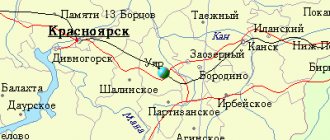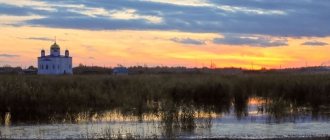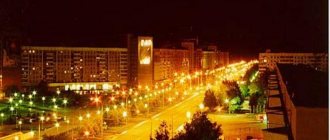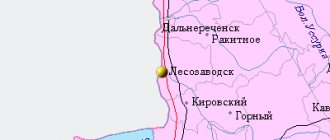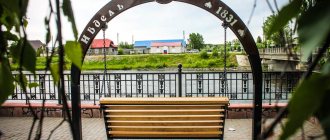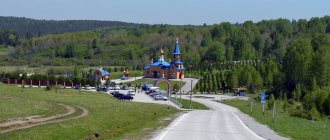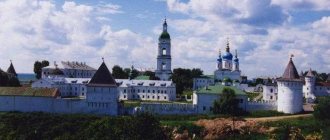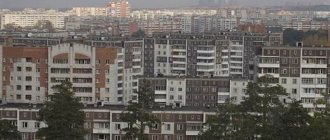Kalachinsk
(until 1919 -
Kalachiki
,
Kalachinskaya
), a city of regional subordination in Russia, the administrative center of the Kalachinsky district of the Omsk region, the cathedral city of the Kalachin and Muromtsevo diocese. Located on the left. bank of the river Om (tributary of the Irtysh), 88 km east of Omsk. Railway Kalachinskaya station on the Trans-Siberian Railway. Automotive unit expensive Population - 22.9 thousand people. (2013) [1]
- On the map: Yandex.Map, Google map
The settlement has been known since 1795. It was founded in the place of a sharp bend of the old riverbed of the Om River, which in Russian dialects was called “kalach”, “kalachik”. Since 1830 - the village of Kalachiki
. In the 19th century, it was populated by unauthorized migrants from Vyatka, Penza and Kaluga villages. In 1838, the Siberian Highway was built near Kalachiki (many residents were engaged in cartage), and in 1895, the Siberian Railway was built.
At the beginning of the 1910s, in Kalachiki there was a store with manufacturing, haberdashery and grocery goods, several small shops, a tea shop, a state-owned wine shop and four beer shops, a bakery store, an oil mill, two forges, a warehouse for agricultural implements, mills, lard melting plants. There was a ministerial one-class school. The fair was held annually from June 29 to July 1. In 1913, a rural hospital was moved to Kalachiki from the village of Kulikovskoye.
Before the revolution, the village was part of the Kulikovo volost of the Tyukalinsky district of the Tobolsk province. On December 5, 1919, by decision of the Sibrevkom, an independent Kalachinsky district was separated from the Tyukalinsky district, which included 16 volosts. Since 1925 - a village, regional center, since 1943 - a settlement. Since December 1952 - a city of district, since 1963 - of regional subordination.
Coat of arms of Kalachinsk: in a silver field with an azure tip, an ear located inside a horseshoe, below accompanied by the date “1795”, all figures are gold; in the green chapter is the name of the city, executed in gold, accompanied below by a black lattice belt, symbolizing the Trans-Siberian Railway. The horseshoe symbolizes the Siberian Highway, its role in the development of Kalachinsk.
In the 1920s, one of the first machine and tractor stations in Siberia was created. According to the “List of Populated Places...” of 1928, the village had schools of the first and second levels, an agronomic center, a library, a hospital, a medical station, a consumer society shop, mills, and a postal and telegraph office [2]. In 1939, a district plant was opened (production of consumer goods). During the Great Patriotic War, a mechanical plant from Melitopol was evacuated to Kalachinsk and reconstructed after the war. The main activity is the repair of agricultural machines and the production of auto-disposal units for livestock farms, tractor trailers, and spare parts. In the 1950s, the Omsk geophysical office of the Zapsibneftegeology association was opened.
In the early 2000s, a mechanical plant, a ceramic wall materials plant, a shoe factory, a weaving factory, and food industry enterprises operated in Kalachinsk; there were eight schools, a vocational school, a cinema, a palace of culture, six libraries, a regional museum, and three hospitals; The regional newspaper "Sibiryak" was published. In the Kalachinsky district, grain and fodder crops are grown, cattle breeding, and poultry farming are carried out; Brick clay deposits are being developed.
Statistics
- 1912 - 165 households, 781 people [3]
- 1926 - 1043 farms, 4243 people [2]
- 1959 – 19 thousand people [4]
- 1970 - 20.8 thousand people [4]
- 1989 – 25 thousand people [4]
- 1998 – 26 thousand people [4]
- 2005 - 23.9 thousand people [4]
- 2010 - 23.5 thousand people [5]
Religion
There is no information about which parish the village belonged to in the first years of its existence. At the end of the 1880s, within the Tobolsk (since 1895 - Omsk) diocese, a parish was formed at the Church of the Intercession in the village of Resurrection, to which the village of Kalachiki was assigned. No later than 1900, a wooden chapel was built here in the name of the holy supreme apostles Peter and Paul, assigned to the Resurrection Church of the Intercession. There is no information about the fate of the chapel building after the establishment of Soviet power in the village; it was probably demolished. Perhaps by 1917, an independent parish was opened in Kalachiki: according to the PSTGU database, this year the priest served here as a priest. Philip Grigoriev.
In the early 2000s, a large brick church was built in the city of Kalachinsk in honor of the Resurrection of Christ, which was under the jurisdiction of the Omsk bishop until June 2012, when it became the cathedral of the newly established Kalachin diocese.
Temples
- Resurrection of Christ, Cathedral
- Peter and Paul, chapel (mentioned 1900 - 1914)
Kalachinsky district of Omsk region
General information about the Kalachinsky district The Kalachinsky district is located in the southern part of the West Siberian Plain, 88 km from Omsk. The area of the region is about 3000 square kilometers. Several highways and the Trans-Siberian Railway line pass through the territory of the region. The administrative center of the city of Kalachinsk is a major transport hub.
Climate of the Kalachinsky district The local climate can be described as moderate continental. The main features of the temperature regime are: short autumn and spring, warm and hot summer, harsh and cold winter. The average monthly air temperature in January reaches –19–20 degrees below zero. Once or twice a century the temperature dropped to minus 50–55 degrees. In July, the thermometer stops at +19 +20 degrees. 80% of precipitation falls during this period. Stable snow cover in the region forms in early November and disappears in early April.
Geographical characteristics of the Kalachinsky district
The territory of the Kalachinsky district is a flat watershed plain with a strongly pronounced western microrelief. There are chernozems, gray forest, meadow, floodplain and saline soils: solonchaks and solonetzes. Intensive human economic activity in recent years has led to increased gully formation. These processes are most clearly manifested on the steep and high slopes of the Omi River, where the city of Kalachinsk is located. The region's lakes have increased mineralization and are noticeably drying out.
Flora and fauna of the Kalachinsky district The territory of the Kalachinsky district is located in the southern forest-steppe zone. Here, birch groves and forest groves alternate with steppe meadows, where crescent alfalfa, meadowsweet, steppe timothy grass, etc. grow. In the center or on the outskirts of forest groves there are meadow-marsh communities with a predominance of grasses and sedges. White, ash and Siberian willows grow in the undergrowth. The fauna includes about 130 species of birds and mammals. Sometimes a wolf and a lynx enter the territory. History of the Kalachinsky district Kalachinsky district was created in May 1925 by transforming the volost of the same name in the Omsk province. The new territorial unit became part of the Omsk Okrug of the Siberian Territory, and after its dissolution it was transferred to the direct subordination of the Omsk Region. Later, the area experienced several enlargements. Today, on its territory there are 55 settlements, home to about 40 thousand people. The city of Kalachinsk is located on the left bank of the river. Om. The first mention of the settlement dates back to 1795. The village got its name from Lake Kalachiki located nearby. The revival of economic life in the region coincided with the construction of the Siberian Highway and the Trans-Siberian Railway. In June 1925, the city was converted into a village, but later returned to its original status. In 1944, Kalachinsk became a workers' village, and in 1952 it became a city. Economy of the Kalachinsky district In terms of industrial production, the district occupies one of the first positions after the regional center. Of the branches of industrial specialization, the most developed is the food industry, which is represented by such enterprises as Kalachinsky Dairy Plant LLC, Kalachinsky Meat Processing Plant OJSC, a vegetable oil mill in the village of Tsaritsyno and many others. The industrial potential of the region consists of mechanical engineering and construction industry enterprises. Sights of the Kalachinsky district Since 1977, the “Kalachin Intersettlement History and Local Lore Museum” has been operating in the regional center. The building of the museum itself is recognized as a historical and architectural monument of the early 20th century. On the steep banks of the Om you can find the remains of ancient settlements and burial mounds. There are many lakes in the area where both local residents and residents of other areas of the Omsk region like to relax.
Story
XVIII century
The first exploration of the territory along the Omi River was carried out in 1755 by ensign Ukusnikov. In 1767, the head of the engineering expedition of the Siberian Corps, Major General Malm, first called the lake Kalachikami, which is a metaphor due to the shape of the lake.
The foundation of the village of Kalachiki was documented by the Revizskaya tale on January 26, 1795. At that time, 14 families numbering 130 people already lived in it. The date of foundation of the village is unknown exactly, approximately in 1783-1794 between the Revision tales.
The official founding date is the spring-summer of 1794. The first houses were built on the steep bank of the Om River, just below Lake Kalach formed by its old bed. The development of the village of Kalachiki proceeded slowly, since there were already small villages around or were newly established; there was never landownership in Kalachiki.
XX century
In 1917, Yakov Martynovich Kalnin, a Latvian poet and teacher, became a member of the food committee of the Kalachinsky district.
At the beginning of 1918, the first district congress of Soviets took place in Kalachinsk, which elected an executive committee headed by chairman Ya. M. Kalnin.
In March 1918, a counter-revolutionary rebellion occurred in Kalachinsk due to attempts to nationalize private property, and in June 1918 there was a direct armed invasion of Kolchak’s troops.
The White Guards surrounded the Kalachin Bolsheviks at the railway station and shot them.
The liberation of Kalachinsk from the Kolchakites ended on November 21, 1919 by the 27th Omsk Rifle Division, which was part of the 5th Army of M. N. Tukhachevsky.
A district revolutionary committee was immediately formed in Kalachinsk, the chairman of which was Jan Petrovich Kroder, a famous Latvian revolutionary.
On December 5, 1919, by decision of the Sibrevkom, the independent Kalachinsky district was separated from Tyukalinsky. It included 16 volosts.
In 1920, the village of Kalachinsk became a district town, and the revolutionary committees were replaced by Soviets.
By 1922, the population of Kalachinsky district exceeded 173 thousand people; at that time, 3,967 people lived in 521 houses in Kalachinsk.
By decree of the Sibrevkom of September 24, 1924, the Kalachinsky district was formed from 6 volosts with 74 settlements and a population of 51,185 people.
The first industrial enterprises in Kalachinsk appeared under Soviet rule: since 1920 there has been a brick factory, an elevator (1938), an industrial plant (1940), and a district meat and milk plant (August 1940).
← previous next →
Pages:
1
Transport
Pictures about the Great Patriotic War
Horse-drawn transport was the only one in Kalachinsk until March 17, 1896, when the first train passed along the rails of the Trans-Siberian Railway. The development of the railway was difficult and uneven. In 1900, the station had a wood warehouse to provide fuel for steam locomotives. 5-6 pairs of trains passed through the station per day. Communication with nearby stations was carried out using a classic Morse apparatus.
On January 1, 1938, the Omsk-Tatarskaya commuter train began operating. By 1955, the transition to electric propulsion was completed. In 1988, more than 300 freight trains passed through Kalachinsk per day.
A branch of the railway is a network of roads. It was created long and hard, in the 1930s it came to the point of forced road conscription to combat impassability. In January 1939, a motor squad consisting of 75 trucks was created. By 1940, the vehicle fleet had grown to 106 units. During the war, the motor squad was mobilized to the front.
note
General information
Full name of the organization: JOINT MILITARY COMMISSARIAT OF THE CITY OF KALACHINSK, OMSK REGION
INN: 5515008088
OGRN: 1025501595558
Location: 646901, region. Omskaya, Kalachinsky district, Kalachinsk, st. Petra Ilyicheva, 3
Organization status: non-profit institution, liquidated (termination of activities of a legal entity through reorganization in the form of a merger)
Organizational and legal form: Institutions (code 81 according to COPF)
Registration in the Russian Federation
The organization UNITED MILITARY COMMISSARIAT OF THE CITY OF KALACHINSK, OMSK REGION was registered in the unified state register of legal entities 22 years ago on October 15, 1999.
The organization was liquidated on September 7, 2007.
The Unified State Register of Legal Entities does not contain information about the types of activities of the organization.
Where is VK G.KALACHINSK located, legal address
VK G. KALACHINSK is registered at the address: 646901, region. Omskaya, Kalachinsky district, Kalachinsk, st. Petra Ilyicheva, 3. ()
There are no other operating organizations listed at the current legal address. However, the following organizations were previously registered here: VC OF THE CITY OF KALACHINSK, KALACHINSKY, KORMILOVSKY AND OKONESHNIKOVSKY DISTRICTS OF THE OMSK REGION (liquidated on July 12, 2010).
Who runs the VK G. KALACHINSK
The head of the organization (a person who has the right to act on behalf of a legal entity without a power of attorney) is the military commissar Vitaly Gennadievich Muromtsev (TIN: 543320050333).
VK G.KALACHINSKA is not listed as a founder of any Russian legal entities.
The organization does not apply special taxation regimes (it is on the general regime).
Persons associated with VK KALACHINSK
Based on data from the Unified State Register of Legal Entities, the following relationships can be traced among persons who are directly or indirectly related to the organization:
Latest changes in the Unified State Register of Legal Entities
- 12/28/2009. Entering information about registration in the Pension Fund of the Russian Federation.
- 03.10.2007. Entering registration information into the FSS of the Russian Federation.
- 09.17.2007. Entering information about registration in the Pension Fund of the Russian Federation.
- 09/07/2007. Entering information about registration with the tax authority.
- 04/26/2007. Changing information about a legal entity contained in the Unified State Register of Legal Entities.
- 01/17/2007. Making changes to information about a legal entity contained in the Unified State Register of Legal Entities due to errors made by the registration authority.
- 02.10.2006. Entering information about registration with the tax authority.
- 11/10/2002. Entering into the Unified State Register of Legal Entities information about legal entities created before 07/01/2002.
Information sources
The data presented on this page was obtained from official sources: the Unified State Register of Legal Entities (USRLE), the State Information Resource of Accounting Reports (GIR BO), from the website of the Federal Tax Service (FTS), the Ministry of Finance and Rosstat. The specified data is subject to publication in accordance with the legislation of the Russian Federation.
Summary statistics for Kalachinsk
Summary statistics of the total number of houses built in Kalachinsk, indicating the total area by year.
| Year of construction | Total area | Number of houses | Number of apartments | Living space | Non-residential area | Non-residential premises |
| 2018 | 1 | 0.00 | 0.00 | |||
| 2015 | 1573 | 1 | 40 | 1573.00 | 0.00 | |
| 2013 | 5494 | 3 | 142 | 4994.00 | 500.00 | 1 |
| 2011 | 3061 | 1 | 60 | 3061.00 | 0.00 | |
| 2010 | 6780 | 2 | 179 | 6780.00 | 0.00 | |
| 2009 | 2163 | 1 | 45 | 2163.00 | 0.00 | |
| 2007 | 12699 | 2 | 199 | 11034.00 | 1665.00 | 3 |
| 2000 | 3092 | 1 | 50 | 3092.00 | 0.00 | |
| 1996 | 10386 | 3 | 220 | 10386.00 | 0.00 | |
| 1995 | 8561 | 4 | 150 | 8101.00 | 460.00 | |
| 1994 | 7501 | 2 | 139 | 7453.00 | 48.00 | 1 |
| 1993 | 1715 | 1 | 32 | 1715.00 | 0.00 | |
| 1992 | 6800 | 3 | 126 | 6800.00 | 0.00 | |
| 1991 | 10383 | 4 | 155 | 9611.00 | 772.00 | |
| 1990 | 7791 | 4 | 147 | 7751.00 | 40.00 | |
| 1989 | 1298 | 1 | 24 | 1298.00 | 0.00 | |
| 1988 | 9448 | 5 | 194 | 9448.00 | 0.00 | |
| 1987 | 1995 | 2 | 44 | 1995.00 | 0.00 | |
| 1986 | 13759 | 5 | 306 | 13529.00 | 230.00 | |
| 1985 | 1299 | 1 | 24 | 1299.00 | 0.00 |
Interesting Facts
In 1960, film director Roman Karmen made a twenty-minute documentary about Kalachinsk, which was shown in all cinemas in the Omsk region and in Moscow.
Kalachinsk is the only city in the USSR in which DUKs (automatic disablers) were produced.
The city of Kalachinsk was visited by the President of the Russian Federation Vladimir Vladimirovich Putin during a trip to Russia.
On April 29, 2008, the IV annual forum-exhibition of business circles of Omsk and districts of the Omsk region was held in the district House of Culture.
